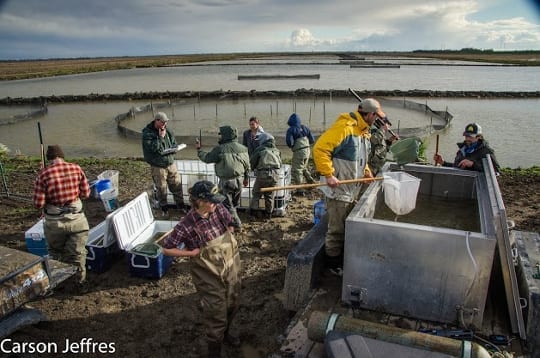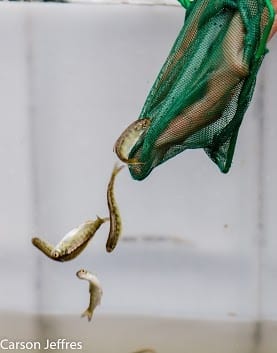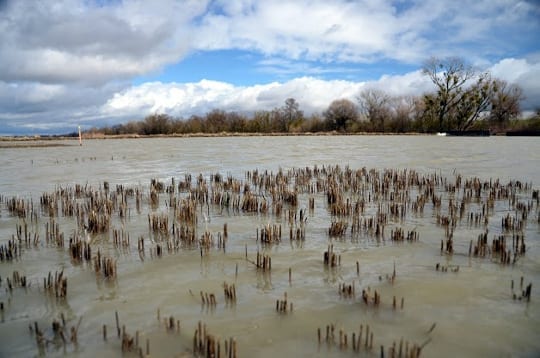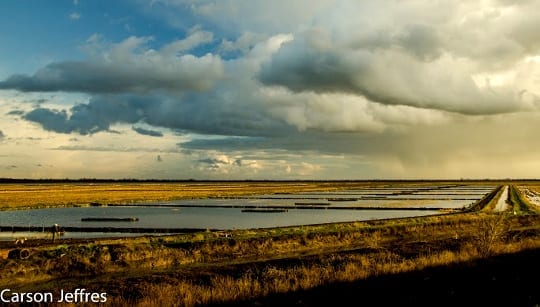CalTrout Study Turns Idle Rice Fields Into Salmon Nursery: Could Hold Key To Central Valley Salmon Restoration
CalTrout Study Turns Idle Rice Fields Into Salmon Nursery: Could Hold Key To Central Valley Salmon Restoration
Studies say salmon grow fastest in flooded Central Valley rice fields — and size really does matter.
One of the keys to salmon recovery in California’s Central Valley may not lie with the river channel, but in the agricultural land abutting it — former wetlands that used to flood each spring, providing a food-rich, safe environment for juvenile salmon to grow before heading to the sea.

Flooded rice fields becoming salmon nurseries? (photo Carson Jeffres)
The last century and a half have seen the Sacramento River channelled, the abundant Central Valley marshes drained and cut off from the river by levees. Today less than 5% of the original wetlands remain.
It’s now clear that the winter and spring flooding of those wetlands was a key part of the Central Valley’s Chinook salmon runs; the seasonal wetlands provided food-rich nurseries for juvenile salmon, who grow faster in wetlands.
Last week, scientists — led by CalTrout Central Region Manager Jacob Katz — flooded rice fields in the Yolo Bypass as part of a study which could prove agriculture and fish can happily co-exist in agricultural fields flooded during the off season.
Bigger Really Is Better
A smaller 2012 study at Knaggs Ranch (Yolo Bypass) suggested that salmon grew much faster in a flooded rice field than they do in the Sacramento River’s main channel.
“Last year’s Knaggs Ranch study saw some of the fastest growth rates ever recorded in the Central Valley,” said Katz.

Salmon fry (photo Carson Jeffres)
“When flooded, there’s a huge amount of fish food in these fields; we’re seeing many times the growth rate compared to the juveniles living in the main river channel — and size is critical to survival in the ocean.”
“Farmers flood rice fields after harvest to help degrade the rice stubble, readying the fields for next spring’s planting” said Katz.
Flooding rice fields became common in the early 1990s to rot rice stubble left in the fields after harvest. Prior to that, rice stubble was often burned, but that created air quality issues.
Flooded fields also provide important fall and winter habitat for ducks, geese and shorebirds, an important side benefit given how few of the Sacramento River’s original wetlands still exist. The Knaggs Ranch study is demonstrating that these same fields can serve as fish habitat too.
“We’re in the process of figuring out the scheduling. I think it looks pretty good” he said.

Salmon fry seeded into the Yolo Bypass (photo Carson Jeffres)
CalTrout Collaborates On Expanded Study
The study — a collaboration between land owners, California Trout, UC Davis, and the California Department of Water Resources — is taking place in the Yolo Bypass, a stretch of farmland and natural habitat created as a flood “pressure release valve” for flood waters, specifically designed to protect the Sacramento metropolitan area.
In 2012, 10,000 juvenile salmon were released on five acres of flooded rice field in the Knagg’s Ranch area of the Yolo Bypass. The results were heartening.
Growth rates were high, and the juvenile salmon emerged in far better shape to survive in the ocean.
This year, the test was expanded.

Rice stubble (photo Carson Jeffres)
Twenty acres, divided into 10 different experimental fields, were flooded and stocked with 50,000 juvenile salmon from Feather River Hatchery. To compare the growth rates of hatchery and fish of natural orgin, salmon captured in the Feather River were stocked in separate pens.
For study purposes, scientists simultaneously released groups of 50,000 juvenile salmon into the main Sacramento River channel and the yolo Bypass canal system to directly compare survival of fish reared in these diverse habitats.
“We are testing the hypothesis that the salmon which grow big on the floodplains have a better chance of surviving in the ocean and returning to spawn. The flooded fields experience an explosion in aquatic insects, which serve as a rich forage base for juvenile salmon.”
“Not only are salmon in floodplains getting a lot to eat, and not burning calories fighting the river current, but they’re better equipped to avoid predators,” said Katz.
Timing Is Everything To Juvenile Salmon
It turns out that size and a lack of predators aren’t the only benefits of floodplains.
Katz added “We also believe there’s an element of timing that favors the juvenile salmon which delay their out migration on the floodplain. They reach the ocean later in spring — when ocean conditions are more favorable to young fish.”
By contrast, the fish in the main channel tend to wash out into the ocean too early — when foraging conditions for fish aren’t optimal.
“The way it stands now, juvenile salmon hit the ocean undersized, undernourished, and before the ocean’s ready to feed them. All of these factors which seem to be limiting Central Valley Chinook productivity are improved by fattening them up on floodplains.”
Finding conservation solutions that work for fish and agriculture isn’t always easy, but in this case, Katz is confident that flooded rice fields can help stand in for the wetlands that once covered the Central Valley.
“We could turn some normally empty fields into truly productive salmon nurseries so when the fish are finally sent downstream, they’ll big and healthy enough to survive.”
“This has the potential to have a huge impact on Central Valley salmon” said Katz.
[*ED: You can view more pictures of the Yolo Bypass/Knaggs Ranch project here (all photos courtesy Carson Jeffres).

The study area in the Yolo Bypass (photo Carson Jeffres).




